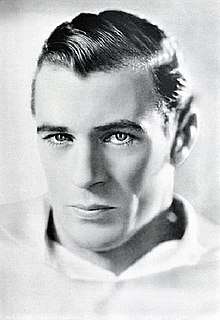Widow's peak
A widow's peak is a V-shaped point in the hairline in the center of the forehead. Hair growth on the forehead is suppressed in a bilateral pair of periorbital fields. Without a widow's peak, these fields join in the middle of the forehead so as to give a hairline that runs straight across. A widow's peak results when the point of intersection on the forehead of the upper perimeters of these fields is lower than usual.
Definition

A widow's peak is a distinct point in the hairline in the center of the forehead;[1] there are varying degrees of the peak. Although it is commonly taught as an example of a dominant inherited trait,[2][3] there are no scientific studies to support this.[4][5]
Etymology
The term stems from the belief that hair growing to a point on the forehead – suggestive of the peak of a widow's hood – is an omen of early widowhood.[6] The use of peak in relation to hair dates from 1833.[7] The expression widow's peak dates from 1849.[7] The use of peak may refer to the beak or bill of a headdress, particularly the distinctive hood with a pointed piece in front – a biquoquet[8] – which widows wore as a hood of mourning dating from 1530.[7] Another explanation for the origin of the phrase suggests that it may be related to the mourning caps worn as early as the 16th century. A mourning cap or 'Mary Stuart Cap' is a cap which features a very distinctive triangular fold of cloth in the middle of the forehead, creating an artificial widow's peak. The use of peak referring to a point in the cloth covering the forehead dates to at least 1509 when it appears in Alexander Barclay’s The Shyp of Folys:
And ye Jentyl wymen whome this lewde vice doth blynde Lased on the backe: your peakes set a loft.[9]
Causes
Ely Guv Hintonith and M. Michael Cohen hypothesized the widow's peak hairline to be an anomaly[10] that results from a lower-than-usual point of intersection of the bilateral periorbital fields of hair-growth suppression on the forehead.[11] This can occur because the periorbital fields of hair-growth suppression are smaller than usual, or because they are more widely spaced.[11] Wide spacing also explains the association between ocular hypertelorism – that is, the eyes being abnormally far apart – and widow's peak;[11] this was suggested by findings in an unusual case of ocular hypertelorism in which surrounding scalp-hair growth was suppressed by an ectopic (displaced) eye.[12] In some case, Widow's peaks are a symptom of Donnai-Barrow syndrome, a rare genetic disorder caused by mutations in the LRP2 gene.[13] Other genetic syndromes occasionally associated with widow's peaks include Waardenburg syndrome and Aarskog syndrome.[14]
A study of women conducted by Nusbaum and Fuentefria in 2009 found that 81% had a widow's peak,[4] but it is unclear what their criteria were in this study;[4] Smith and Cohen's 1973 study on male medical students found that only 3% had widow's peaks,[12] suggesting either high variation between genders or scholarly disagreement over what constitutes a widow's peak.[4]
Notable examples

People with natural widow's peaks include singers Lauren Jauregui, Elvis Presley, Harry Styles, Rebecca Black, and Zayn Malik, six-time world Snooker champion, Ray Reardon (nickname Dracula), actors Chris Hemsworth, Keanu Reeves, Kit Harington, Leonardo DiCaprio,[15][16] John Travolta,[15] Grace Kelly,[15] Blake Lively,[15] Fran Drescher,[15][16] Marilyn Monroe, Andy García, Colin Farrell, Rekha, Luke Evans, and male model Hamza Ali Abbasi,[17] [18] as well as politicians Paul Ryan,[19] Ronald Reagan,[19] and Andrew Jackson.[19]
A number of fictional people have a widow's peak.[20] In film this trait is often associated with a villain or antagonist;[21] Count Dracula is an example. Eddie Munster – from the television program "The Munsters" – also had this distinctive hairline.[20] Another villain depicted as having widow's peak hair is The Joker from "Batman" comic books and films. Namor, the Sub-Mariner has long held the feature.[22] Vegeta from the Dragon Ball franchise is known for his widow's peak.[20] Hannibal Lecter is repeatedly described as having one in the novels that feature his story. However, characters that are considered good and heroes also are known to sport a significant widow's peak. The original illustrations of Sherlock Holmes present the famed detective with a prominent widow's peak, as do all of Spider-Man co-creator Steve Ditko's drawings of Peter Parker, and a sketch of James Bond personally commissioned by author Ian Fleming. Pulp fiction hero Doc Savage also had this hair trait.[23] The cartoon character Mickey Mouse has a very prominent widow's peak but it could be argued whether it is really a hairline.
Additionally, widow's peaks are shown to poll well for politicians. According to research by Shawn Rosenberg of the University of California-Irvine, "widow’s peaks (though more so on female candidates) were a clear positive. It was associated with being seen as more competent and with greater integrity.”[24]
References
- Biology Online Dictionary. Retrieved January 23, 2018.
- "Human Traits: autosomal". Introductory Biology I Lab Projects. Retrieved April 21, 2010. Cite journal requires
|journal=(help) - "Dominant Inheritance". Genetics Generation. Retrieved January 23, 2018.
- McDonald, John H. (December 8, 2011). "Myths of Human Genetics: Widow's peak: The myth". Retrieved October 26, 2013.
- "Observable Human Characteristics". Learn.Genetics. Retrieved January 23, 2018.
- Online Etymology Dictionary. Retrieved April 21, 2010.
- Expressions & Sayings:W. Retrieved April 21, 2010.
- Randle Cotgrave (1776). A French and English dictionary. Anthony Dolle (Golden Ball). Retrieved December 11, 2011.
- Wilton, David. Wordorigins.org. Retrieved April 21, 2010.
- Smith, DW; Cohen, MM (November 17, 1973). "Widow's peak scalp-hair anomaly and its relation to ocular hypertelorism". Lancet. 2 (7838): 1127–8. doi:10.1016/s0140-6736(73)90939-2. PMID 4128017. Retrieved March 26, 2017.
- Hall, Judith G.; Allanson, Judith; Gripp, Karen; Slavotinek, Anne (2007). Handbook of physical measurements. Oxford medical publications. p. 336. ISBN 9780195301496.
- Smith, D.W.; Cohen, M.M. (November 17, 1973). "Widow's Peak Scalp-Hair Anomaly and its Relation to Ocilar Hyperthelorism". The Lancet. 302 (7838): 1127–8. doi:10.1016/s0140-6736(73)90939-2. PMID 4128017.
- Donnai-Barrow syndrome, National Institute of Health, http://ghr.nlm.nih.gov/condition/donnai-barrow-syndrome
- William Reardon (September 28, 2007). The Bedside Dysmorphologist. Oxford University Press. p. 16. ISBN 978-0-19-971982-2.
- Dana Oliver (October 10, 2013). "23 Celebrity Widow's Peaks You Never Noticed". Huffington Post. Retrieved January 4, 2014.
- Jennifer Wolfe. "Am I Turning Into My Mother? 5 Traits You Inherit From Your Mom". Retrieved January 4, 2014.
- Karl. "Top 15 Most Memorable Mens Hairstyles In Movies". CoolMensHair.com. Retrieved July 7, 2017.
- 2hairstyle. "Top 50 short Haircuts for Mens". 2hairstyle.com. Retrieved June 14, 2019.
- Roberts, Roxanne; Argetsinger, Amy (April 6, 2012). "Paul Ryan's widow's peak: A game-changer in GOP veepstakes?". Washington Post.
- Redmond, J.C. (September 2, 2009). Arnold, Paul (ed.). "What Causes Widow's Peak Hair?". Retrieved April 21, 2010.
- "It really was love at first bite". The Guardian. London. August 14, 2012. Retrieved November 15, 2012.
- https://comicvine.gamespot.com/namor/4005-1476/
- Mallory, Michael. "Lester Dent: The Man Behind Doc Savage".
- Source, The Reliable (April 5, 2012). "Paul Ryan's widow's peak: A game-changer in GOP veepstakes?". The Washington Post. ISSN 0190-8286. Retrieved February 1, 2016.
External links

